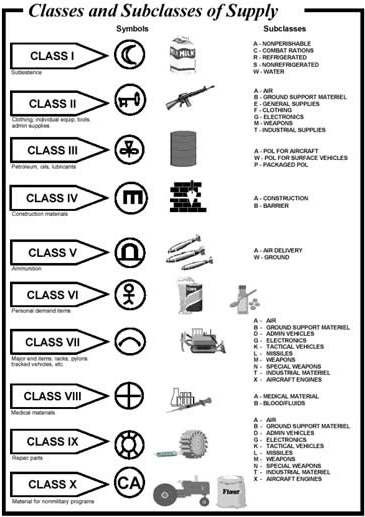U.S. Military Supply Chain and Logistics Analogies
The military has had to manage the task of supply chain management on a large scale for quite some time. Due to the similarity in mission lengths of long-range aircraft and vessels, we found it an appropriate analog for space exploration missions. The objective of this task is to study long-range military supply chains to provide close analogies for space exploration and evaluate their potential application to interplanetary supply chains.
Aircraft Carrier and Submarine Logistics

We found it imperative to narrow down our scope to a few specific military systems. Those chosen were that of aircraft carrier and submarine logistics. These make close analogies because of the long duration of the missions and relatively remote environments. Within these systems, we are focusing on studying the classification of supply, use of forward positioning, sparing techniques, and maintenance and repair policies.
Military Supply Classes
In studying the use of forward positioning of supplies in the military, it was found that the Marine Corps makes considerable use prepositioning forces. Further study of the Marine Prepositioning Force (MPF) was warranted because of its high success rate during Operation Iraqi Freedom. An MPF can be sustained for about 30 days with a complete Maritime Prepositioning Ships Squadron (MPSRON). Supply characteristics for both MPFs and space missions are compared in the following table:
| Military | Space | |
|---|---|---|
| Types of Supplies | Equipment, vehicles, combat sets, spares | Fuel, vehicles, maintenance supplies, critical spares |
| Waste Disposal | Human and hazardous waste | Human and hazardous waste |
| Perishability/ Obsolescence | Consumables, supplies subject to modernization | Consumables |
| Stowage | Large (20-ft or 40-ft) cargo containers | Stowage bags and racks |
| Transfer | Cargo transfer with roll-on/roll-off ships | Docking, refueling, crew transfer |
| Location | On land, at sea; high risk areas | Surface and Orbital Nodes (LEO, L1); ISS |
| Transport Modes | Sealift, Airlift | STS, Soyuz, ATV, CEV, LSAM, CLV, CaLV |
| Size of Crew | 18,000 (size of Marine Expeditionary Unit) | 3-7 |
While several characteristics show large deviations, including types of transport modes and the size of the crew/force, we can apply techniques from other areas where there is a closer resemblance between the military and space exploration.
Future Work
Further study of the SSN-688 Los Angeles class submarine and the F/A-18 aircraft carrier will be undertaken with the help of the Lean Aerospace Initiative (LAI) at MIT.LAI has performed significant research in the areas of enterprise architecting and organizational change. This research has been applied to supply chain management in studying the roles and relationships between key players in a supply chain. This viewpoint will aid in giving a more overarching examination of military supply chains and the context in which specific systems operate.
